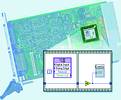
With the release of LabVIEW 7 Express, National Instruments continues to deliver tools to help make its user’s distributed monitoring and control systems better integrated, faster and easier to develop – and spanning across additional platforms. A distributed system consists of specific computing nodes which are connected through software to form an integrated whole. For instance, users may need to share data from a logic controller to their data acquisition system that is on the opposite end of a factory floor, in another factory, or even in another country. Typically this integration is taking place over an Ethernet, GPIB, or serial-based network where a central server is communicating to each specific node.
Typical distributed systems might include:
* Several testing systems sending data to a central control room.
* Data acquisition systems sending data directly to a PDA which then sends the data wirelessly to a central host.
* Sensors sending data directly to a server through Ethernet.
LabVIEW 7 Express and the LabVIEW 7 Realtime, datalogging and supervisory control, PDA and FPGA module help users build well integrated, distributed systems that can expand to FPGAs running on reconfigurable I/O.

Programming computing nodes
National Instruments is a leader (and a pioneer) in virtual instrumentation, where its products can bring a variety of signals and data into the PC environment. Whether from a PLC, GPIB instrument, or data acquisition board, users can bring this data to the PC where they can log the data to a database for future analysis or analyse it on their desktops. The latest release of LabVIEW extends the deployment options to include PDAs and FPGAs on reconfigurable I/O boards.
This PDA module may be used to build a LabVIEW program that can run on a PDA and then communicate to a variety of different test systems through 802.11b, TCP or UDP. Users can then sync their PDA data files with their host PCs for further analysis.
The FPGA module offers the power to configure the functionality of a reconfigurable I/O board (PXI-7831R) to build or prototype FPGA-based systems. Commercial off-the-shelf technology, together with the FPGA system, enables the user to quickly and efficiently prototype their FPGA application or build a system to emulate custom-digital protocols without having to sacrifice the time to build custom hardware or program VHDL code.
Integrating computing nodes
Each node of a distributed system plays a unique role and hence has variable requirements when it comes to integrating each piece together. Consider a PLC: LabVIEW may be used to connect to the PLC's OPC server by using the DSC module. This module will allow the user to create tags from the OPC server, which can then be called by LabVIEW. Once imported, these tags are used to interface with data from a variety of I/O such as a compact FieldPoint-based or data acquisition system. Users can then reliably log any of this data to a networked database, trend the data or have the data initiate an alarm.
Networking each computational node in a distributed system - where data can be shared reliably and quickly - is essential. Ideally, a user could integrate numerous nodes together over the network and have a central server to correlate data from specific nodes together, analyse data from different sources or log the data for later use. LabVIEW can connect each node in a distributed system using networking technology like TCP or UDP. Additionally, users can control applications remotely using ActiveX or .NET Web Services, or present data to other nodes within a Web browser using the built-in Web publishing tools.
LabVIEW is a useful tool for being able to easily and quickly network nodes on a distributed system together. Facilitating a consistent software development environment for networking and measurement tools saves time and allows for better integration for an entire system. The same consistent language may be used to program the distributed communication, the data acquisition, and with the newest development platforms, program the functionalities of FPGAs on reconfigurable I/O or bring in data to the network using a PDA.
Enhanced tools for building distributed systems
LabVIEW 7 has made it easier and more cost effective to build distributed systems with the introduction of Express VIs, additions to the LabVIEW DSC and realtime modules, and more visually intuitive block diagrams. With the addition of Express VI, users can configure common acquisition, analysis or presentation tasks by dropping down an Express VI on the block diagram and clicking through the property pages.
Interconnecting nodes is easier with the LabVIEW 7 Real-Time Communication Wizard and the LabVIEW 7 DSC HMI Wizard. With a few clicks these wizards generate code that will complete the distributed monitoring, control or realtime application, almost halving application development time. The power of a distributed monitoring application may be increased with the new historical database viewer, rewritten database and improved ODBC and SQL interface in the LabVIEW 7 DSC Module.
LabVIEW has introduced functions that make block diagrams more intuitive. The feedback node, which is identical to the shift register functionally, allows access to data from past loop iterations and is a more visually intuitive, especially for closed-loop control applications. The flat sequence structure is a sequence structure that is laid out like a filmstrip instead of having each frame laid on top of subsequent frames.
Conclusion
Using LabVIEW 7 Express to build a distributed system is a suitable solution for a development environment that spans the entire spectrum of an application. Whether the user is acquiring their data from various signals, sending or viewing that data over a network, or reliably logging that data to a database, LabVIEW has the necessary tools to build that distributed system. Choosing LabVIEW as the application environment will result in a consistent programming environment, the ability to connect to a breadth of data sources, and an easy to use, yet powerful development tool.
For more information contact Michael Hutton, branch manager, National Instruments SA, 011 805 8197.

© Technews Publishing (Pty) Ltd | All Rights Reserved